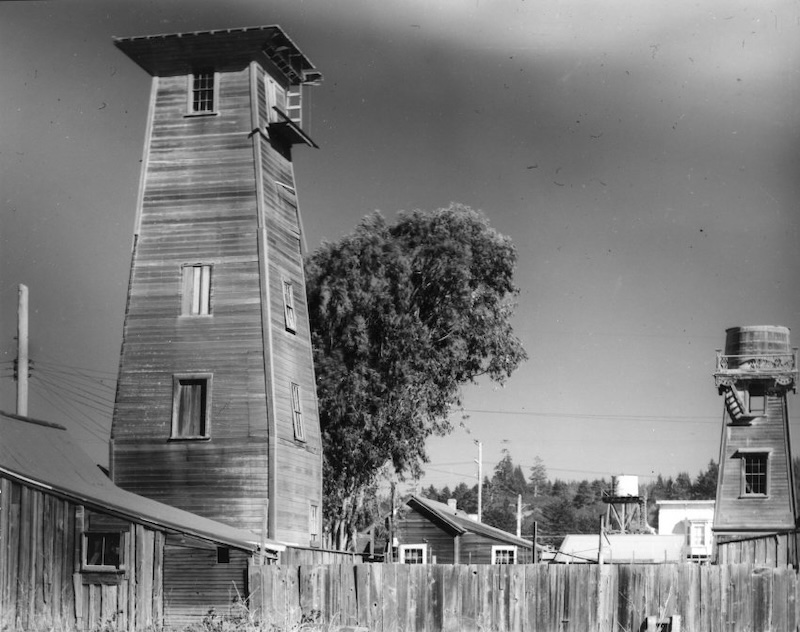The questions posed most frequently by visitors to the Kelley House Museum have to do with Mendocino’s water towers: why are they here, how do they work, why are some so tall? What were once utilitarian devices that conducted water into houses have become charming and iconic objects of fascination and mystery. To satisfy the curiosity of tourists and locals alike, the Kelley House has just brought out an updated version of “Water Towers and Windmills of Mendocino,” by Wally Smith. First published in 1993, the new edition adds to the impressive amount of information found in the earlier one and corrects a few errors that recent research has uncovered.

Photo: Three water towers are visible in this 1948 photograph by William Heick taken from Calpella Street facing northeast: on the left in front is Hagenmeyer’s (built 1884) on Calpella Street; in the middle distance on the right is J.D. Johnson’s (built 1885) on Lansing Street; and far off in the middle is the Perry-Hazeltine tower (built 1908) on Howard Street.
One of the best descriptions of Mendocino back in the heyday of its water towers and windmills, and one that answers most of the questions above, is found in the book’s first pages. “Staging in the Mendocino Redwoods” was written by journalist Netta Eames in the San Francisco-based Overland Monthly in summer, 1892. She was in a stagecoach traveling north from Little River when she caught her “…first glimpse of Mendocino City, one of the oldest and most picturesque of all the coast towns. Viewed from a distance on shore or at sea, the city seems to have an imposing array of cupolas, which are in reality water tanks, with attached windmills of every known pattern. There is an individuality about the water works of this town not found in any other place of its size.”
“Every family or group of families has its separate well and windmill, thus obviating the necessity of a general source of water supply. One sees windmills painted in red, white, blue, or dark shades of maroon and yellow, and still others so ancient and wind-tortured that their distinctive color can only be guessed. When the wind blows, and there is rarely a day here that it does not, these diverse windmills set up a medley of discordant creaks and groans, each pitched in a different key, all nerve-rending. Presumably one can get used to the constant screeching for nowhere are there people more serene and healthy than in this breezy town.”
All things considered, it’s good that electricity came to the coast around 1900, putting an end to the need for the constantly screeching windmills. Pumps powered by electricity generally make much less noise, but it’s too bad there are so few windmills left; it’s easier to explain water’s trip from the ground to a tank on high when it has an attached windmill. When Wally Smith wrote the first edition, there were still old timers around who remembered not only what the windmills did, but also many other facts about them and the water towers: who first built them, when they blew down in wind storms, whether they were rebuilt, when they were moved or taken down, by whom, and why. The book is full of water tower reminiscences and boasts a new and improved centerfold map to help aficionados find still-standing water towers or the locations of legendary ones.
More recently, stalwart Kelley House volunteers Karen McGrath and Carol Dominy (who is also our social media maven) spent hours poring over old Mendocino Beacon articles, scrutinizing Sanborn maps, and digging through the museum archives to add to our information about Mendocino’s water towers. The fruits of their labors are manifest in the new edition. Abundant black and white photos of many towers grace the volume, complemented by sections that demonstrate how to build one, how to move one, and how to make one work. The book does not describe how to turn one into a dwelling unit or overnight accommodation, though that is what has been done to a number of them. Staying in a Mendocino water tower was recently said by the Los Angeles Times to “give one a natural high.” And, with some product from a nearby dispensary, the sky is the limit. “Nowhere are there people more serene….”
Back down on terra firma, the new edition of “Water Towers and Windmills of Mendocino” is available at the Kelley House for $25. Stop by and pick up a copy or order online. The museum is open from 11 AM to 3 PM Friday through Sunday. To speak with the curator, make an appointment with her at curator@kelleyhousemuseum.org Walking tours of the historic district – which include lots of information on, and views of, the water towers – are available throughout the week; the cost is $25. Visit the Kelley House Event Calendar for a Walking Tour schedule.